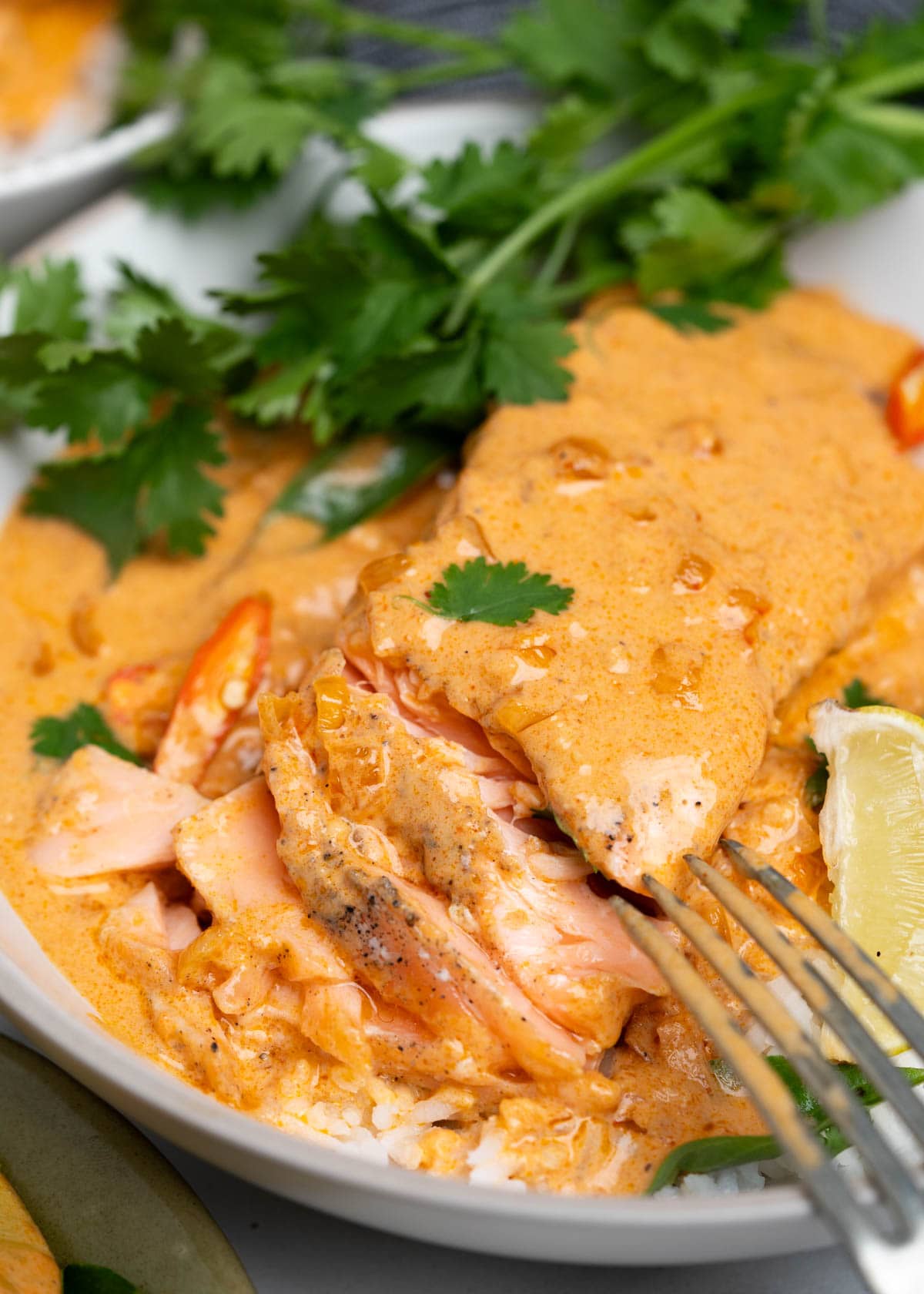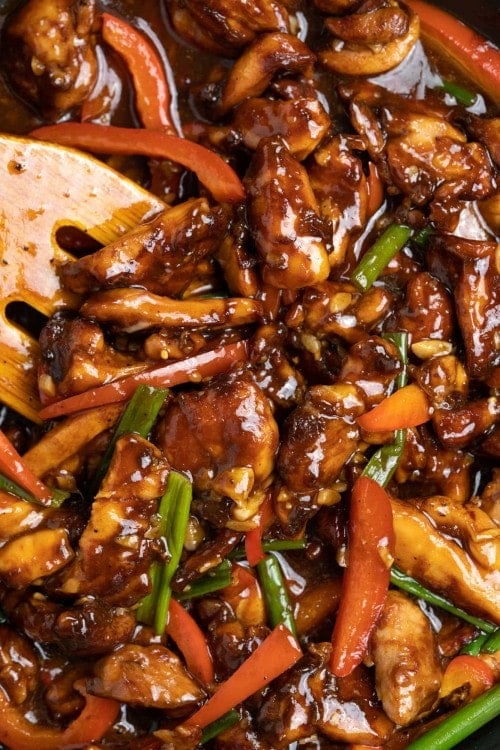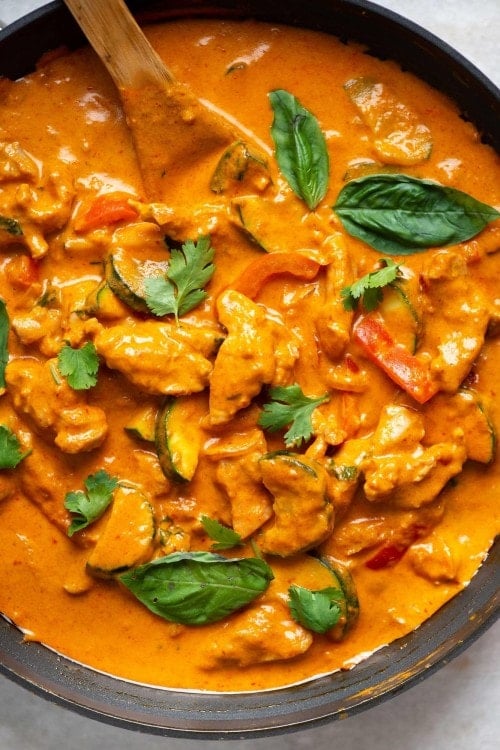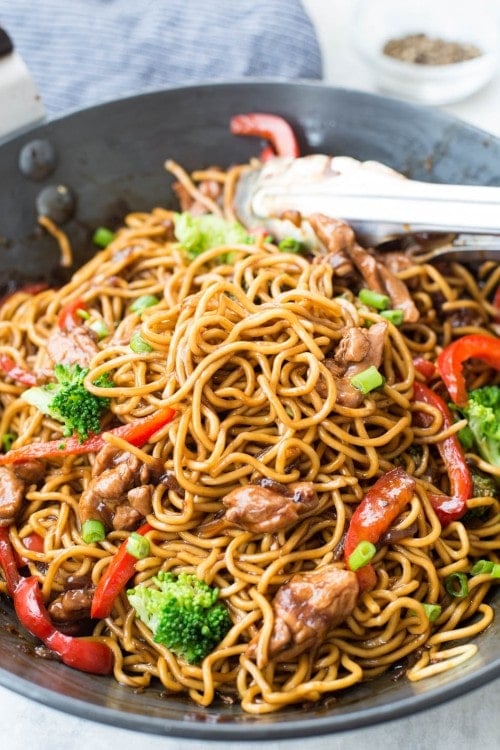Coconut Salmon Curry
Creamy coconut curry, aromatic spices, and tender seasoned salmon fillets result in a curry with a balance of sweet, savory, and spicy flavors.
I love salmon for its mildly sweet flavor and buttery richness and have shared a few delicious recipes over the years: Air Fryer Salmon, Best Salmon Patties, Baked Salmon in Chili Lime Marinade, and Lemon Honey Glazed Salmon.

Coconut curry is a staple in many regions of Southeast Asia and other places where there is an Indian culinary influence. Salmon coconut curry has likely come from a fusion of fresh local produce like salmon with the popular coconut curry sauce.
It is creamy from coconut milk, savory from the red curry paste, sweet from the sugar, and tastes rich and buttery from the salmon. Among the legion of curries that I have made, Thai coconut curry stands out, mainly because of the perfect balance of flavors, I feel. It has umami, creaminess, spiciness, and sweetness—something for all of us.
I like salmon for its mild, sweet, and delicate texture. Added to the coconut curry, it offers a nice option for similar flavors, like Thai Red Curry. Salmon is a meaty fish with oceanic tastes, and being a fatty fish, it tastes rich and buttery. This taste profile blends well with the balanced flavors of the coconut curry sauce. It doesn’t have a very strong flavor and hence pairs well with a variety of sauces and seasonings.
For a few Thai-inspired dishes, check out Thai Cashew Chicken Stir Fry, Thai Chicken Coconut Soup (Tom Kha soup), Thai Red Curry With Chicken, and Thai Grilled Chicken.

What do we need?
- Salmon: I have used fresh salmon cut into fillets.
- Coconut milk: I have used coconut milk, though you can also use coconut cream instead. This makes the gravy creamy.
- Red curry paste is a flavorful and aromatic ingredient used in Thai cuisine. Easily available in stores or for extra freshness, it can be homemade by blending the ingredients.
- Fish sauce and soy sauce: both sauces are salty, and soy sauce is used for its savory taste, while fish sauce gives an umami boost.
- Ginger, garlic, and onion are common aromatics that are used to form a flavor base in curries. Grated ginger offers warmth, while minced garlic and diced onion are often sauteed together for their aroma and spicy notes.
- Olive oil: we are going to sear the salmon as well as sauté the aromatics with this
- Brown sugar: you get the sweetness to balance the other spicy and pungent flavors in the curry.
- Kaffir leaves, lime, and cilantro: the citrus aroma and hints you get in Thai curries come from them.
- Salt and pepper: bring out the other flavors while adding a touch of heat.

How to cook
- Season salmon fillets: Season the salmon fillets with salt and pepper and let them rest for 15-20 minutes before cooking.
- Sear salmon: Heat olive oil on a hot pan and sear the fillets for 4 minutes with the skin side down. Flip and sear for another 4 minutes. Keep them aside.
- Saute aromatics: on the same pan, add oil and sauté onions first, then sauté until they turn soft. Saute garlic and ginger for a minute.
- Red curry paste: Add red curry paste to the pan and sauté for another minute.
- Add coconut milk: Add coconut milk to the pan and stir until the paste mixes completely. Let it simmer for a couple of minutes until it forms a smooth sauce.
- Add the spices: Add the sugar, salt, and pepper. Mix well, and let the curry simmer for a couple of minutes. Add the sauces, lime juice, kaffir leaves, and chili and mix well.
- Fillets to skillet: Now place the salmon fillets in the curry and pour the sauce over the fillets. Switch off the flame and serve.

Tips for best results
- Moderate red curry paste: Salmon is a delicate, mildly sweet fish that can get easily overpowered with spicy pastes. Moderate your use of red curry paste. You can add bird’s eye chili for heat or increase the pepper.
- Do not season for too long. Seasoning the salmon fillets for 20 minutes is enough for salt and pepper to do their work on the tender fillets. Do not go longer than that, as salt can dry out the fillets over time.
- Cream over milk: Coconut cream is thicker and has a concentrated coconut flavor. It will make the curry richer and creamier. If that upsets the balance of the flavors, diluting it with water or stock will work. You might also need to adjust the quantities of spices to maintain a balance of taste and flavor.
- Use high-fat coconut milk: High-fat content in the coconut milk will prevent the curry from curdling.
- Don’t boil the curry: This curry is just to be simmered after you add the coconut milk. Boiling runs the risk of curdling the milk.

Storage instructions
Salmon coconut curry reheats well, and you can store it in an airtight container for up to 4 days.
To reheat, do so on the stovetop by gently simmering it again. If the curry appears to separate, stir it until it mixes. You may also reheat it in the microwave.
If you feel the curry has become watery, just add a dash of coconut milk and stir.
Serve with
This salmon coconut curry is best served with rice like steamed white or basmati rice, jeera rice, or jasmine rice. Even fresh, soft breads like roti or naan are good to scoop up the delicious gravy.
Similar curry recipes
- Slow Cooker Coconut Chicken Curry – A coconut-flavored creamy sauce made with chicken
- Dhaba Style Egg Curry – eggs made in a curry style that are popular in highway eateries in the Indian subcontinent
- One-Pot Chickpea Curry (Chana Aloo) – Chickpeas made in a Dutch oven with Indian spices, making it a nutritious meal.
- Thai Butternut Squash Curry – Fall favorites like butternut squash paired with tofu and Thai flavors make it a creamy and delicious dish.
- Creamy Cauliflower Curry (Vegan) – Indian-inspired cauliflower curry is paired with coconut milk, making a luscious creamy gravy that is also gluten-free and keto-friendly.
- No Oil Chicken Curry – Chicken curry made without any oil and a yogurt-based gravy.



Coconut Salmon Curry
Ingredients
- 4 salmon fillets
- Salt & pepper to taste
- 3 tablespoon olive oil
- ½ onion diced
- ½ tablespoon garlic minced
- ½ teaspoon ginger
- 2 tablespoons Thai red curry paste
- 1 teaspoon fish sauce optional but recommended, see note
- 1 teaspoon soy sauce
- 1 13.5 ounce can full-fat coconut milk
- 2 teaspoon brown sugar
- 2 teaspoon lime juice
- 2-3 kaffir lime leave
- 1 bird eye chilli optional
- 2 tablespoons chopped fresh cilantro
Instructions
- Season Salmon fillets on both sides with salt and pepper.
- Heat 2 tablespoons of oil in a skillet. Place Salmon fillets skin side down and sear for 3-4 minutes without moving. Carefully flip and cook for another 4 minutes. Remove salmon from the skillet and keep aside covered.
- To the same skillet, add rest of the oil. Saute onion for 2-3 minutes until soft. Then add minced garlic and ginger. Saute on low heat for about a minute, until the raw smell is gone.
- Stir in the red curry paste and saute for 1 minute. Add a splash of water if the mixture is getting stuck to the skillet.
- Pour coconut milk into the skillet and mix well until the mixture is creamy and no lump of red curry paste in the mix.
- Then add brown sugar, salt, and pepper. Simmer for 1-2 minutes.
- Season with Soy sauce, fish sauce, and lime juice. Add crushed Kaffir lime leaves and slit bird-eye chili if using. Give everything a good mix.
- Carefully place the cooked salmon fillets back to the skillet. Pour of the curry sauce on the fillets and switch off the flame.
- Sprinkle fresh cilantro on top and serve.















